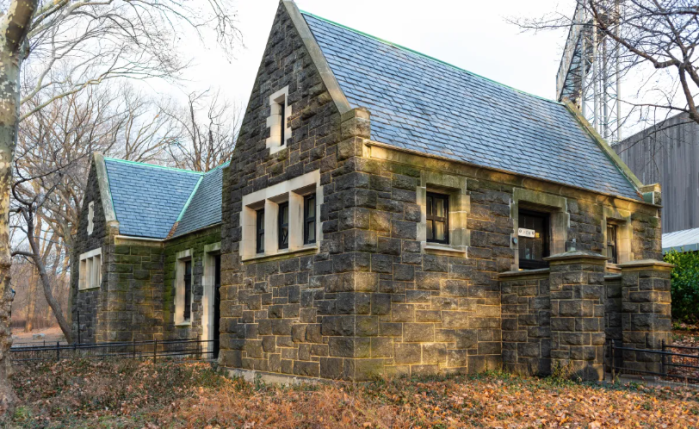Council Member Sandy Nurse (D-Brooklyn) talking Pre-Acknowledged Press Convention forward of the passage of her toilet invoice
Picture by Emil Cohen/NYC Council Media Unit
The place to pee could not be a urgent query for New Yorkers’ bladders after the Metropolis Council handed a invoice Thursday to create a long-term strategic planning course of for establishing and sustaining a city-wide public toilet community.
Brooklyn Metropolis Council Member Sandy Nurse’s invoice goals to make it simpler to discover a restroom throughout town by mandating at the very least one restroom per 2,000 residents by 2035.
Generally known as Intro 694-A, the invoice requires related metropolis businesses to provide a strategic planning report that’s up to date each 4 years. The purpose is to offer at the very least 2,120 public bogs by the yr 2035, at the very least half of which will likely be publicly owned. The businesses would even be required to submit a complete on-line map of all public bogs within the metropolis.
“Today, we are voting to make New York City flush with public toilets,” Nurse mentioned forward of the vote, which unanimously handed on April 10. “Every single person walking around New York City should be free to pee in a private, clean, functioning bathroom. No one should have to experience the humiliation or stress of having to relieve themselves out on the street.”
Whereas introducing the laws final September, Nurse famous that the Metropolis has not meaningfully elevated its variety of public bogs for the reason that Seventies, saying the “ongoing policy failure” disproportionately impacts weak populations resembling seniors, folks with disabilities, pregnant people, households, homeless folks, supply staff, road distributors, and taxi drivers.
“Since then, our city has grown, our city budget has grown, but somehow we have not managed to address this issue,” mentioned Nurse on Thursday. “Through intro 694-A for the first time, our city agencies will not only have to actually come up with a plan to maintain and expand a citywide public bathroom network, but they’ll have to plan every four years. Right now, we don’t have a plan. We don’t have a strategy. We have a hodgepodge of agency-specific processes that create a disjointed, stunted, and some might call foul approach.”
The Metropolis has made current efforts to handle toilet entry, together with a Council invoice requiring town to complete constructing 151 new public bogs that it pledged to construct in 2022 and Mayor Eric Adams’s plan to construct 46 new public toilets and renovate one other 36.
As a part of Nurse’s invoice, the strategic plan should be up to date each 4 years and embody “a capital strategy, recommendations for law or policy changes to support bathroom openings or conversions, and identify various types of sites that could be converted for public bathroom use.” Moreover, town would designate “one or more design models for a modular public bathroom that could be installed in a variety of types of sites or facilities.”
The laws additionally mandates a complete on-line map of all public bogs citywide, which would come with hours of operation, ADA accessibility, whether or not a price is required, and upkeep duty.
 The stone bathroom block in Central Park, considered one of some 700 public bogs maintained by the Parks DeptPhoto by way of Getty Photos
The stone bathroom block in Central Park, considered one of some 700 public bogs maintained by the Parks DeptPhoto by way of Getty Photos
Advocates who testified earlier than the council final yr mentioned the measure was urgently wanted in a metropolis the place simply over 1,100 public bogs serve a inhabitants of 8.6 million. “That’s only one public restroom per 7,500 residents in New York, and only two that are open 24 hours a day, seven days a week,” testified Willie Woods of the Open Hearts Initiative, who has Crohn’s illness and has skilled homelessness.
“The level of urgency can be overwhelming. Sometimes, it functions like a fully automated process that I cannot stop. During a Crohn’s flare, I can no longer plan travel from one destination to another – I have to plan from bathroom to bathroom. That can often double my travel times–which then exacerbates the need for a bathroom in and of Itself,” added Woods.
A 2024 report from the Metropolis Council discovered that two-thirds of NYC public restrooms both had well being and security hazards or have been saved closed throughout working hours.
“Access to bathrooms is a public health and quality of life issue for everyone… It mainly impacts homeless New Yorkers who, in their search for places to alleviate themselves, are met with tickets,” mentioned Adolfo Abreu of VOCAL-NY, referring to the practically 9,400 summonses – legal and civil – issued by NYPD in 2023 for public urination
A Fiscal affect assertion concluded that the invoice would don’t have any anticipated price to town funds. “It is anticipated that there would be no impact on expenditures… as the Department of City Planning, the Department of Parks and Recreation, and the Department of Transportation would utilize existing resources to fulfill this legislation’s requirements,” the Council’s Finance Division reported.
Beneath the laws, a Deputy Mayor will lead the hassle in coordination with metropolis businesses such because the Division of Metropolis Planning, Parks, and Transportation. If signed into legislation by Mayor Eric Adams, the primary city-wide toilet technique report could be due by Sept. 1, 2026.
“Access to public bathrooms is essential to New Yorkers’ health, safety and quality of life,” mentioned Speaker Adrienne Adams following the vote. “This Council is proud to address the longstanding issue of the city’s lack of public bathrooms. Today’s action to promote more transparency on compliance and progress towards Streets Master Plan goals is critical step forward for greater accountability.”






